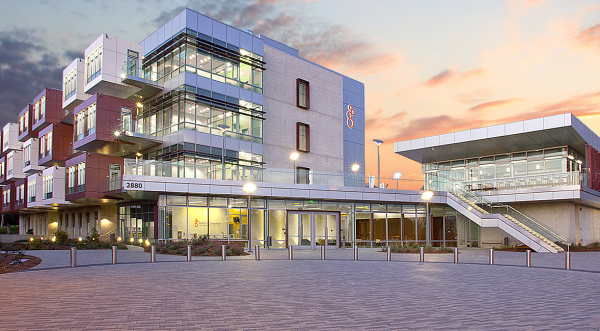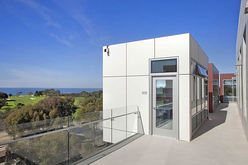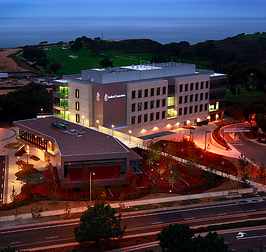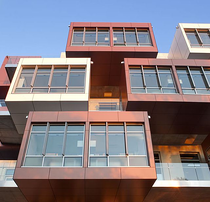[Award-winning, ultramodern and unique Sanford Consortium lab research building]
When the Sanford Consortium for Regenerative Medicine recently opened the doors to its new laboratory research building on the "Mesa" in La Jolla's elite biotech neighborhood along Torre Pines Drive, more than a few people were impressed. Designed to catalyze collaboration between stem cell scientists from five of the major San Diego research institutes (UCSD, Salk, Scripps, Sanford-Burnham, and newcomer to the group, the La Jolla Institute for Allergy and Immunology), the building was dubbed "The Collaboratory." While every campus seems to be scrambling to create as much interaction as possible among researchers in their new science buildings, this one clearly hits the mark. The 7-month-old laboratory facility was recently awarded the 2012 Gold Nugget Grand Award, arguably the oldest and most prestigious design award in the country. As one judge commented about the winning lab building: “There is a lot to love about this project."
If you remember seeing a photograph of the front of the Sanford Consortium stem cell building under construction in an earlier blog of ours, you can be forgiven for not recognizing it now. Those cantilevered, super-articulated office pods that you enter from an outdoor passageway (photos below) and glassy lab spaces are on the more scenic side of the building, not facing the street but rather a golf course, a gliderport, and the ocean. And what are they, those protrusions? They look a bit like cells in the process of division, though really they're just a literalization of the idea of pulling lab modules apart, almost as if you were carefully removing a series of Jenga pieces. And that disruptive edginess is exactly the point. Not to disrupt concentration, but to take researchers out of the realm of the familiar and ask them to engage with each other and their research as if tomorrow's technology could make today's obsolete. Which it might very well.
[Office pods branching out on the western side of the new stem cell research building, and sky view at night]
In addition to the main laboratory building, the center also includes a second building housing an elegant cafeteria at one end (below right) and a 150-seat auditorium at the other, both open to the public. This is the low structure connected to the lab building by a plaza in the photos, with a lobby/lounge under the plaza level. The auditorium (below left) was specifically designed to be small and intimate, based on studies that suggest 150 as the maximum number of people you can have in a group and maintain a sense of connection and interaction. That's just one of the design principles that have won this building complex accolades generally and the Golden Nugget Grand Award in particular. With almost 3000sf of glass in the buildings, reclusivity is not encouraged, whereas transparency and sociality are. Natural light is also abundant with all that glass, and in fact the building is on track to achieve LEED Gold certification as well.
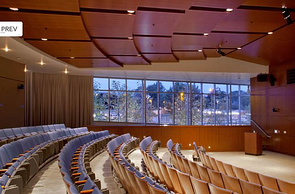
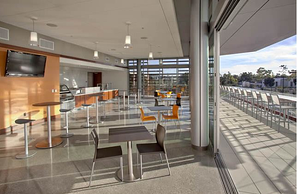
[The auditorium and cafeteria, courtesy of the Sanford Consortium for Regenerative Medicine]
Some of the elite stem cell scientists taking up residence in the new building include:
- Catriona Jamieson, University of California San Diego: Directs stem cell research at the Moores Cancer Center. She studies early cells that give rise to cancer stem cells, hoping to develop more personalized and less toxic cancer therapies.
- Fred Gage, UCSD and the Salk Institute: Searching for stem cell-based therapies to treat psychiatric disorders and neurodegenerative diseases, such as autism, schizophrenia and Parkinson’s disease. Gage is using stem cells from Parkinson’s patients to try to replicate the disease in a lab while also studying the role inflammation plays in the disorder.
- Anjana Rao, La Jolla Institute for Allergy and Immunology: Exploring what happens in embryonic stem cells as they turn into different types of cells. Such information could prove valuable in her lab's efforts to coax stem cells into becoming liver, heart and other organ cells for transplant purposes.
- Robert Wechsler-Reya, Sanford-Burnham Medical Research Institute: Studies how normal stem cells make decisions, including when to divide and when to develop into other cell types. He identified a new type of stem cell that can give rise to medulloblastoma, the most common malignant brain cancer in children.
- Martin Friedlander, The Scripps Research Institute: Conducts stem cell research that focuses on the eye and potential treatments for a range of retinal vascular and degenerative diseases, including diabetic retinopathy, age-related macular degeneration, glaucoma, and retinitus pigmentosa.
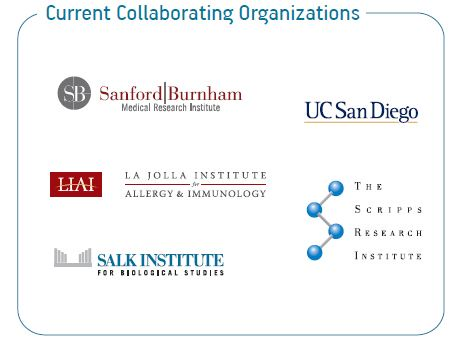
Biotechnology Calendar, Inc. was founded 20 years ago to bring scientific events and new technologies to life science researchers at UCSD. Now a nationwide science tradeshow and marketing company, we still hold our popular flagship San Diego Biotechnology Vendor Showcase™ event twice annually on the La Jolla campus, with investigators attending from across the life science community, including invitees from all of the research institutes making up the Sanford Consortium.
Our next BVS expo takes place August 23, 2012. For information on exhibiting and a free funding report, click the button below:


